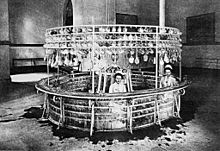Pump room (spa facility)


A drinking hall , also known as a fountain hall , is a mostly closed building near the local springs, as part of a health resort in health resorts , in which the fresh healing water is distributed to the spa guests. The so-called fountain maids used to be responsible for this. The history of the pump room is directly linked to the development of the well treatment.
history
The drinking cure became increasingly important in the 17th century and gradually replaced the previously common bath cure . While a contained spring and facilities with individual baths were required for bathing, the drinking cure required a weatherproof room for serving water, in which the spa guests could also stay. Since these initially belonged to the nobility and the upper middle class, it went without saying that the spa buildings also had a representative character. Many fountain halls were built in the style of pavilions .
A special spa architecture has emerged in the spa towns since the 18th century. In Bad Lauchstädt , the Elector of Saxony had spa facilities built from 1776 to 1782, which also included a wooden arcade . But that wasn't a pump room yet. An early example is the fountain and fountain hall built by Karl Friedrich Schinkel in Bad Aachen in 1823 . The Baden-Baden drinking hall and the drinking hall in Bad Ischl in the Salzkammergut in Austria were also built in the classicism style in the 19th century .
When Fyodor Dostoyevsky was on a drinking cure in Bad Ems , he described the procedure in a letter: “You give them (the well girl, add.) Your glass and they immediately fill it with water. During the two hours allotted for the morning cure, thousands of sick people pass by this balustrade; every patient drinks several glasses during these hours (...) the same thing is repeated in the evening cure. (...) You only need to say once, immediately after arrival,: 'This is my glass, I will get so and so many ounces of creamer and so and so much milk' - and she will not be wrong once during the entire treatment. "
Since the drinking cure included slow going back and forth, the “promenading”, so-called “ Wandelhallen ” (walk-through halls) were created parallel to the drinking halls as a weatherproof walkway.
See also
literature
- Rolf Bothe (Hg): Spa towns in Germany. On the history of a building type. Berlin 1984, ISBN 3-88725-002-8 .
- Petra Simon and Margrit Behrens: Spa treatment and health spa. Buildings in German baths 1780–1920. Munich 1988, ISBN 3-42400-958-X .
Web links
Individual evidence
- ↑ Quoted from Hans-Jürgen Sarholz: History of the City of Bad Ems. 1994.
